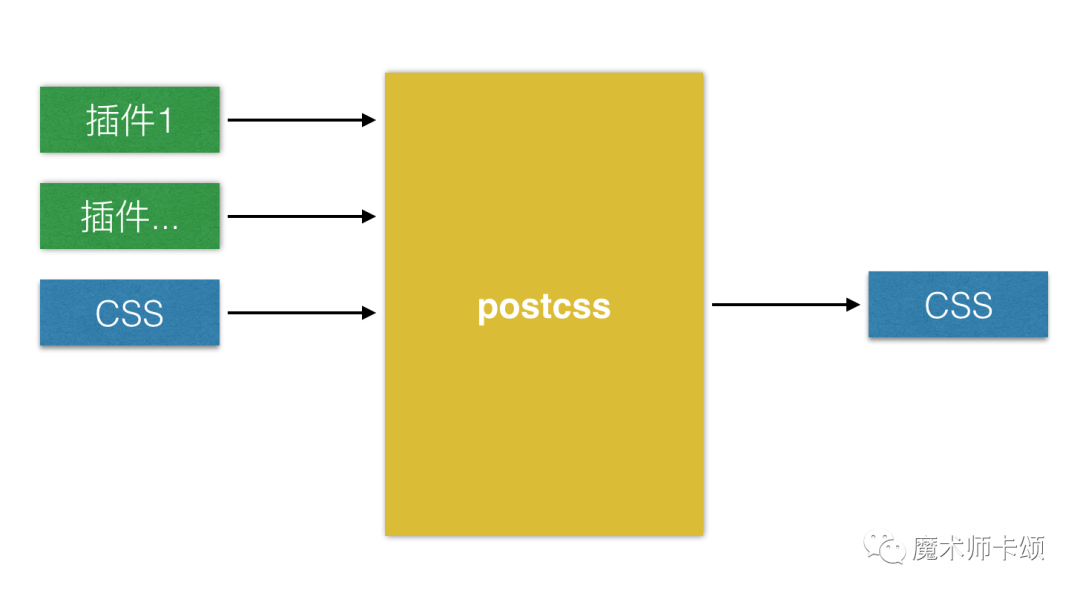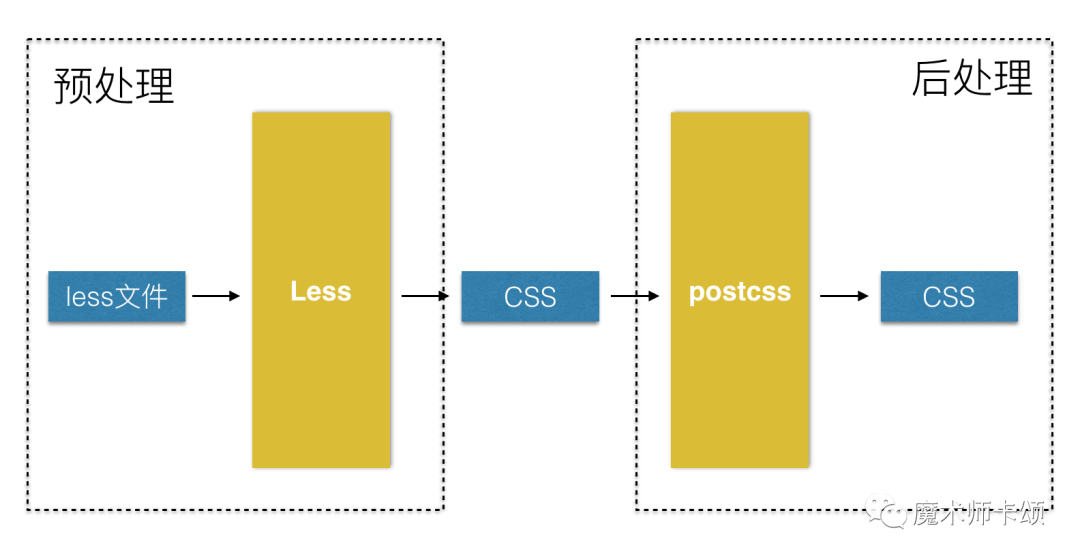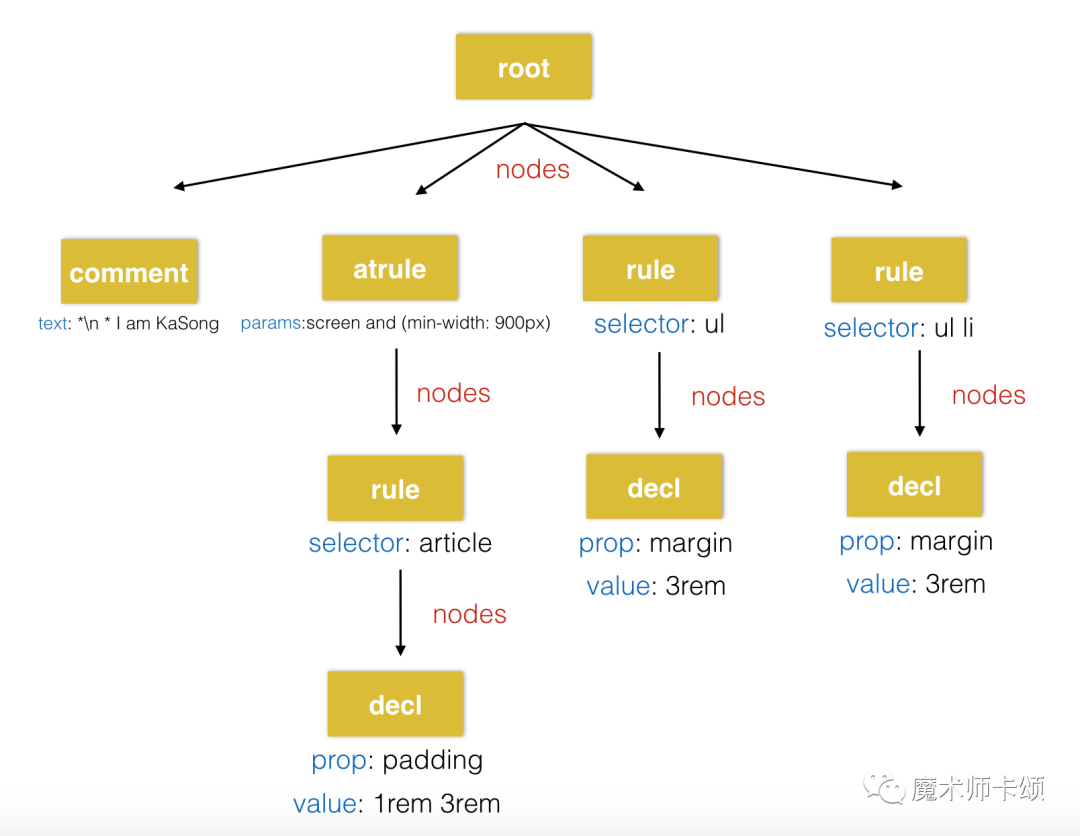解剖postCSS —— 向前端架构师迈出一小步
最近很火的TailwindCSS有一个功能:
可以将项目未使用的css选择器从编译后css文件中移除。

这个功能是PurgeCSS实现的。
链接TailwindCSS与PurgeCSS的,则是一个postCSS插件@fullhuman/postcss-purgecss。
不仅TailwindCSS,还有很多知名项目中使用了postCSS插件。比如:
很多人在项目中使用autoprefixer插件,为css选择器增加不同的「浏览器前缀」。
在其内部会根据browserslist[1]指定浏览器版本。
再去caniuse[2]查找该浏览器版本兼容性支持情况。
最后通过postCSS的能力改写不支持的css属性。
可以看到,postCSS正越来越成为前端项目必不可少的依赖。
同时也有很多关于postCSS的误区,比如认为他是和Less、Sass一样的「css预处理器」。
本文会自底向上介绍postCSS,希望通过此文让你对这款大杀器有更深的认识。
什么是postCSS
postCSS是一款css编译器。
类比Babel家族的@babel/parser可以将js代码解析为AST(抽象语法树),再利用众多插件(@babel/plugin-xx)的能力改写AST,最终输出改写后的js代码。
postCSS利用自身的parser可以将css代码解析为AST,再利用众多插件(上文介绍的autoprefixer就是一种)改写AST,最终输出改写后的css代码。

从这点就能看出其与Less这样的「css预处理器」的不同 —— postCSS的输入与输出产物都是css文件。
因此,postCSS也被成为「后处理器」,因为其通常在css处理链条的最后端。

postCSS的AST
你可以在astexplorer[3]中选择:
语言:css
parser:postCSS
来了解postCSS如何解析css。
比如,对于如下css代码:
/**
* I am KaSong
*/
@media screen and (min-width: 900px) {
article {
padding: 1rem 3rem;
}
}
ul {
margin: 3rem;
}
ul li {
padding: 5px;
}
会被postCSS解析为如下树结构的AST:

节点有如下几种类型:
Root:根节点,代表一个
css文件AtRule:以
@开头的申明,比如@charset "UTF-8"或@media (screen) {}Rule:内部包含定义的选择器,比如
input, button {}Declaration:
key-value键值对,比如color: black;Comment:单独的注释。
selectors、at-rule的参数以及value的注释在节点的node属性内
实现一个简单的插件
接下来我们从一个插件的实现来了解开发者如何介入postCSS编译流程。
postcss-focus[4]会为所有:hover选择器增加:focus以提高键盘操作的可用性。
对于如下代码:
.a:hover, .b:hover, .c:hover {
opacity: .5;
}
经过该插件处理后会输出:
.a:hover, .b:hover, .c:hover, .a:focus, .b:focus, .c:focus {
opacity: .5;
}
你可以安装postcss、postcss-focus后通过如下demo在控制台看到结果:
const postcssFocus = require('postcss-focus');
const postcss = require('postcss');
const fs = require('fs');
// 输入的css文件地址
const from = 'src/a.css';
const to = 'output/a.css';
fs.readFile(from, (err, css) => {
postcss(postcssFocus).process(css, { from, to }).then(result => {
console.log(result.css)
})
})
接下来我们分析postcss-focus源码[5]的实现逻辑:
postCSS将输入的css解析为AST遍历
AST中所有Rule类型节点维护一个数组,遍历这个节点的所有
selector,每遍历到一个包含:hover的selector就往数组中push一个:focus的selector将2中得到的数组
concat到该节点已有的selectors后根据改变后的
AST输出新的css
核心源码如下:
{
postcssPlugin: 'postcss-focus',
// 步骤1
Rule: rule => {
// 步骤2
if (rule.selector.includes(':hover')) {
let focuses = []
for (let selector of rule.selectors) {
if (selector.includes(':hover')) {
let replaced = selector.replace(/:hover/g, ':focus')
if (!hasAlready(rule.parent, replaced)) {
focuses.push(replaced)
}
}
}
// 步骤3
if (focuses.length) {
rule.selectors = rule.selectors.concat(focuses)
}
}
}
}
这个插件只是为了演示插件的基本工作方法,实际上该插件实现的比较粗糙。
postCSS提供了详细的插件创建文档[6]。甚至提供了create-postcss-plugin[7]用来创建插件的模版代码。
更多可能性
由于提供了表达、改写css AST的能力,postCSS的插件可以实现非常多功能。比如:
postcss-functions
上文介绍了Declaration节点表达「css属性」的键值对,其中值为「字符串」类型。
那么完全可以自定义值的解析规则。
body {
color: getColor();
}
通过定义getColor函数,并在AST中将其解析为函数执行,就能在css文件中用js写逻辑代码。
这就是postcss-functions[8]
stylelint
配置不同的lint规则,实现css的静态语法检测。这就是stylelint[9]
总结
当前postCSS插件按功能划分大体有如下几类:
解决全局
css问题,比如提供css module[10]支持使用未全面兼容的
css特性,比如autoprefixer[11]格式化,提高
css可读性图片和文字处理
linters,比如
stylelint不同语法的
css支持,比如postcss-html[12]可以解析类html文件中<style>标签内的css语法
读到这里,相信你会同意:相比Less、Sass,postCSS才是css处理领域的大杀器。
参考资料
browserslist: https://github.com/browserslist/browserslist
[2]caniuse: https://caniuse.com/#search=
[3]astexplorer: https://astexplorer.net/
[4]postcss-focus: https://www.npmjs.com/package/postcss-focus
[5]postcss-focus源码: https://github.com/postcss/postcss-focus/blob/master/index.js
[6]插件创建文档: https://github.com/postcss/postcss/blob/main/docs/writing-a-plugin.md
[7]create-postcss-plugin: https://github.com/csstools/create-postcss-plugin
[8]postcss-functions: https://www.npmjs.com/package/postcss-functions
[9]stylelint: https://github.com/stylelint/stylelint
[10]css module: https://github.com/madyankin/postcss-modules
[11]autoprefixer: https://github.com/postcss/autoprefixer
[12]postcss-html: https://github.com/gucong3000/postcss-html
爱心三连击
1.看到这里了就点个在看支持下吧,你的在看是我创作的动力。
2.关注公众号脑洞前端,获取更多前端硬核文章!加个星标,不错过每一条成长的机会。
3.如果你觉得本文的内容对你有帮助,就帮我转发一下吧。
